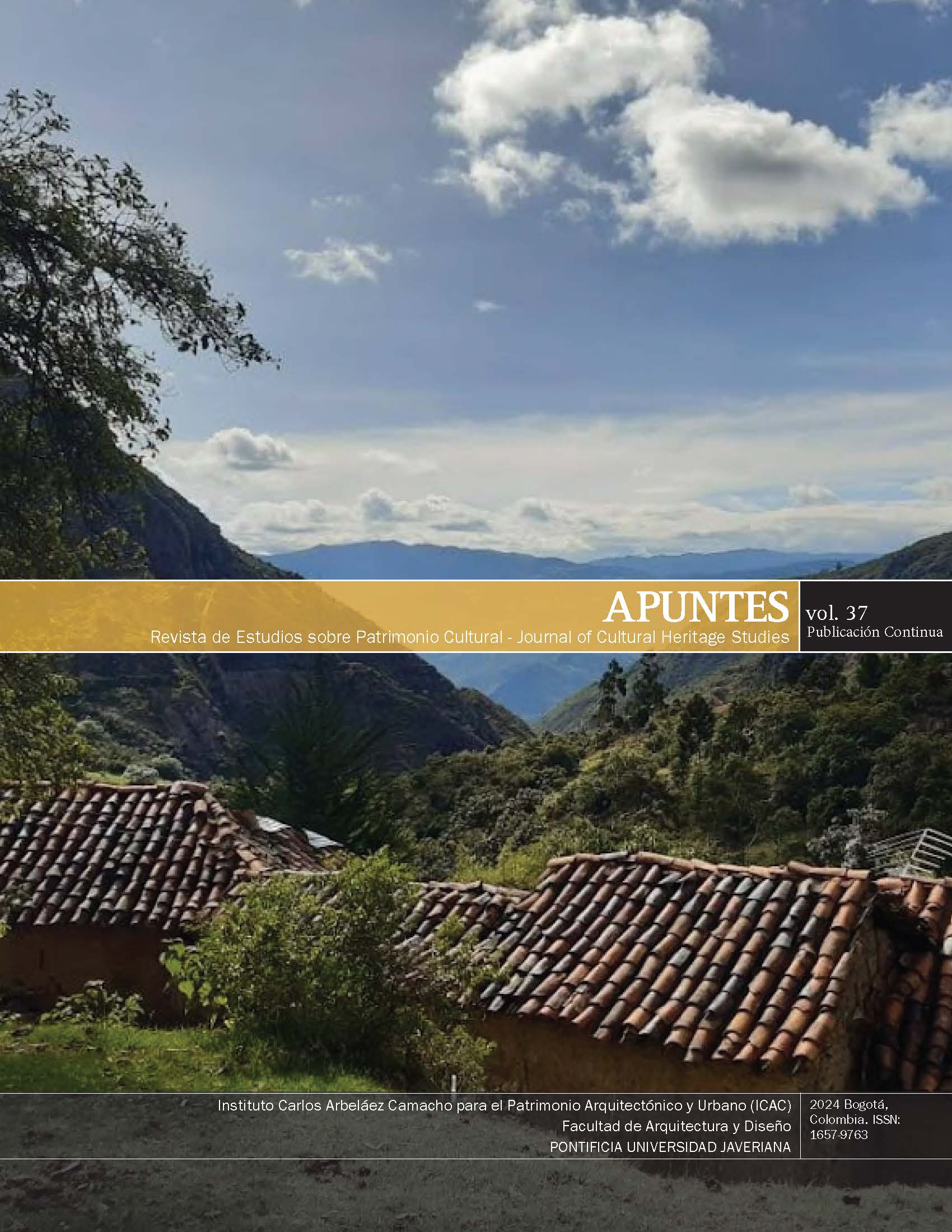Abstract
Public art opens up various forms of artistic consumption, new urban galleries expose cultural diversity with free access to the viewer, generating a collective appropriation of the works. The objective of this research was to compile and interpret the public artistic production that San Antonio de Ibarra has, based on the census of forty works between murals and sculptures, the analysis of the theme, techniques used and the vision of the art consumer in relation to they. This study is qualitative-descriptive, with a dialectical hermeneutic approach. The results obtained were based on the analysis of observation sheets of each work and the interpretation from different contexts, as well as the contribution of interviews conducted with two leading artists of muralism and sculpture of the parish. In conclusion, San Antonio de Ibarra has works of great value in its public space, which preserve the cultural and artistic heritage of its people, and are part of an open gallery that gives way to the appropriation of the values of each work by of the public that visits the sector, considering it as an important tourist reference in the social, cultural, artistic and economic development of the parish.
Abreu, J, G. (2013), Arte Pública. Origens e condição histórica, Arte Pública Envolvimento Comunitário. Atas do Colóquio Internacional.
Aguilar, H. Arte, consumo y alienación Un estudio sociológico sobre los efectos de la modernidad y el consumo en el arte [Tesis de Grado Universidad Nacional Autónoma de México]. UNAM – Dirección General de Bibliotecas. http://132.248.9.195/ptd2013/enero/0687730/0687730.pdf
Arnavat Carballido, A. (2017). Un recorrido por el arte urbano de Imbabura. https://rb.gy/l8yod7
Blanco-Arroyo, M. A. (2011). El consumo del arte en la economía de mercado actual. ASRI: Arte y sociedad. Revista de investigación, 14.
Calva, K. R. (2022). Efectos del Arte Público en la Ciudad Contemporánea. MAGOTZI Boletín Científico de Artes del IA, 10(19), 13-20.
Chang, T. C. (2019). Writing on the Wall: Street Art in Graffiti‐free Singapore. International Journal of Urban and Regional Research, 43(6), 1046-1063.https://doi.org/10.1111/1468-2427.12653
Condori-Ojeda, Porfirio (2020). Universo, población y muestra. Curso Taller. https://www.aacademica.org/cporfirio/18.pdf
De Lecea, I. (2004). Arte público, ciudad y memoria. On the w@ terfront, 5-17. https://www.raco.cat/index.php/Waterfront/article/view/214755
Favre, P. S. (2015). Escenarios del poder: la escultura en el Parque General San Martín.https://bdigital.uncu.edu.ar/objetos_digitales/14049/favre-escenariosdelpoder.pdf
Fernández López, A. E. (2020). Una mirada a Las Palmas de Gran Canaria a través de sus bustos (Master's thesis). https://accedacris.ulpgc.es/handle/10553/73494
Gobierno Autónomo Desentralizado de San Antonio de Ibarra [GAD], (2022).XII Simposio de Escultura en Motosierra. https://rb.gy/co77nj
Galea, Iliana. (2022, 16 febrero). Arte mural: qué es, historia, características, técnicas y mejores obras de la pintura mural o muralismo (imágenes). Cinco Noticias https://www.cinconoticias.com/arte-mural/
Gayo, E. G. (2019). El espacio intermedio del arte urbano. Ge-conservacion, 16, 154-165. https://rb.gy/kwszi2
García Canclini, N. (1995). Consumidores y Ciudadanos. Conflictos multiculturales de la globalización, Ed. Grijalbo
Gómez, P. (2018). Manual básico de Historia del Arte. Universidad de Extremadura, Servicio de Publicaciones.
Guasch, A.M. (2009), El arte ultimo del siglo XX Del posminimalismo a lo multicultural, Novena reimpresión,Alianza forma.
Guía de San Antonio de Ibarra - Pueblos Mágicos Ecuador, (2021, April 7). Issuu. https://issuu.com/ecuadortravelinvestigacion/docs/guia_pm_santonio_ibarra1
Heredia López, A. E. (2022). Retrospectiva de la bienal nacional de escultura San Antonio de Ibarra (Master's thesis). https://rb.gy/mjldkz
Herrera, M. (2022). “Las esculturas de San Antonio de Ibarra y los simposios de motosierra”. En persona. San Antonio de Ibarra.
Jimenez, C. (2016, March 26). En San Antonio de Ibarra sobrevive la Escuela Quiteña. El Telégrafo https://rb.gy/ijdpgy
Luque-Rodrigo, L. (2020). La gestión del arte urbano,¿ una cuestión pendiente?. La Colmena, (106), 81-98. https://lacolmena.uaemex.mx/article/view/13191
Mata, D. (2020, May 19). Entrevistas semiestructuradas en investigación cualitativa. Investigalia. https://rb.gy/sgnvdt
Matos, E. Fuentes, H. Montoya, J. y Quesada, J. (2007) Didáctica: lógica de investigación y construcción del texto científico. https://rb.gy/mpoeh7
Ministerio de Cultura y Patrimonio. (2019). Cultura y patrimonio.gob.ec. https://rb.gy/exgeec
Montejo, Y. S. (2012). Espacios y arte públicos. Un acercamiento desde Bayamo. ASRI: Arte y sociedad. Revista de investigación, (1), 34-12. https://www.eumed.net/rev/ays/1/ysm.html
Nolivos, S. L. P., Romero, A. A. V., & Rodríguez, R. S. (2020). Repensando el concepto de arte a través del turismo: el turismo de arte callejero en Guayaquil. RES NON VERBA REVISTA CIENTÍFICA, 10(2), 136-153.
Perez, C. (2017, April 29). En San Antonio destaca el arte con motosierra. El Telégrafo. https://rb.gy/hpwrw1
Perez Paradiso, M. C. (2021). Proyecto cultural: Galería Urbana: aplicación móvil sobre muralismo.[Tesis maestría]. https://rb.gy/xu5ynf
Peist-Rojzman, N. (2022). Lo culto y lo popular en el arte. Algunas teorías sociales sobre la diversidad cultural. Arte, Individuo y Sociedad, 34(2), 649. [Pdf]
Posso, M. (2013). Proyectos, Tesis y Marco lógico, Planes e Informes de investigación.Ediciones Noción
Ramos, M. J. M. (2009)“La Importancia del Arte en nuestra sociedad”.Revista Innovación y Expreiencias Educativas.
Reiss, I. H. (2022). ¿ Cómo pensar el arte público? A 100 años del muralismo mexicano. Revista mexicana de ciencias políticas y sociales, 67(246), 121-154.
Remesar, A. (2016). Arte público. Retos y oportunidades (II). La consolidación de los lenguajes. On the Waterfront. The International on-line Magazine on Waterfronts, Public Art, Urban Design and Civil Particiapation, 2016, vol. 41, num. 2, p. 7-59.
Romero, F. A. (2020). Tradición y transmisión de la fe. El caso de la<< religiosidad popular>> en el Chile actual. Scripta Theologica, 52, 215-243. [pdf]
Ruiz, L. (2019, March 4). Técnica de observación participante: tipos y características. Psicologiaymente.com. https://rb.gy/pqnc4z
Tellez, O. (S.f). arte y consumo artístico otHóN téllez. Cuadernos de Turismo Cultural https://rb.gy/khvr7q
Tutillo, D. (2022). “Los murales de San Antonio De Ibarra”.En persona. San Antonio de Ibarra.
UNESCO. (21 de 11 de 1972). Convención sobre la Protección del Patrimonio Mundial, Cultural y Natural.http:// whc.unesco.org/archive/convention-es. pdf
UNESCO. (2020, May 10). Patrimonio cultural. UNESCO. https://rb.gy/udcgo5
Uriarte, J.(2022). ESCULTURA. Humanidades.com. https://humanidades.com/escultura/.
Villada, C. M. L. (2009). Arte público y ciudad. REVISTA IMAGO, (3).

This work is licensed under a Creative Commons Attribution 4.0 International License.
Copyright (c) 2024 Andrea Paola Chuquín Cadena, Miguel Posso -Yépez


